Dodo
| Dodo Temporal range: Late Holocene
| |
|---|---|

| |
| Dodo reconstruction reflecting modern research, at Oxford University Museum of Natural History[1] | |
| Scientific classification | |
| Kingdom: | |
| Phylum: | |
| Class: | |
| Order: | |
| Family: | |
| Subfamily: | |
| Genus: | Raphus Brisson, 1760
|
| Species: | R. cucullatus
|
| Binomial name | |
| Raphus cucullatus (Linnaeus, 1758)
| |
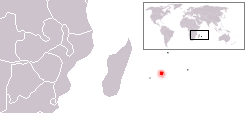
| |
| Former range (in red) | |
| Synonyms | |
| |
The dodo (Raphus cucullatus) is an extinct flightless bird endemic to the Indian Ocean island of Mauritius. The species lost the ability to fly presumably because food on Mauritius was abundant and mammalian predators were absent. It is genetically related to pigeons and doves, and its closest relative is the likewise extinct Rodrigues Solitaire. The dodo is believed to have stood about one metre (3.3 feet) tall and to have weighed about 20 kilograms (44 lb). Its appearance is evidenced only by paintings and written accounts from the 17th century. Because these vary considerably, and only a few sketches are known to have been drawn from life, its exact appearance remains a mystery. The same is true of its habitat and behaviour. A white dodo was also speculated to have lived on the Mascarene island of Reunion, but this now known to have been a misconception.
The dodo was first mentioned by Dutch sailors in 1598. By 1681, all dodos had been killed by hungry sailors, their domesticated animals, and other invasive species introduced during that time. Its extinction was not immediately noticed, and it was considered a mythological creature until the 19th century, when research was conducted on some of the few surviving specimens brought to Europe in the 17th century. Since then, a large amount of sub-fossil material has been collected from Mauritius, increasing the amount of evidence relating to the bird. The extinction of the dodo within 80 years of its discovery called attention to human involvement in the extinction of plants and animals, which previously had not been recognised.[3]
The dodo achieved widespread recognition due to a notable role in Alice in Wonderland, and has since become a fixture in popular culture. Its name has subsequently become associated with the concepts of extinction and obsolescence.
Taxonomy and evolution
Many different affinities have historically been suggested for the dodo, including to ostriches and vultures, until Johannes Theodor Reinhardt proposed they were ground doves, based on studies of a dodo skull in Copenhagen:[4]
"The Dodo agrees in the form of the majority of its cranial bones, and even in the shape of the beak, with the prevailing type of the Pigeons, as I had perceived, in common with my colleague v. Hamel, in the summer of 1846."

This view was later supported by Hugh Edwin Strickland and Melville after a dissection of the preserved head and foot from a stuffed specimen at Oxford Museum, but it remained controversial.[5] The theory has recently been confirmed by mtDNA cytochrome b and 12S rRNA sequence[6] analysis, wherein DNA extracted from a tarsal from the dodo foot in Oxford was compared with genetic material from other birds, indicating that the ancestors of the dodo diverged from those of its closest known relative, the likewise extinct Rodrigues Solitaire, around the Paleogene-Neogene boundary. As the Mascarene Islands are of volcanic origin and less than 10 million years old, the ancestors of both birds likely remained capable of flight for some considerable time after the separation of their lineages.
The same study has been interpreted to show that the Southeast Asian Nicobar Pigeon is the closest living relative of the dodo and the Rodrigues Solitaire.[7] The generic name of the dodo-like Tooth-billed Pigeon from Samoa is Didunculus, which means "little dodo",[8] and it was also shown to be genetically similar to the dodo in the study. However, this proposed phylogeny is problematic regarding the relationships of other taxa.[9] The dodo and the Rodrigues Solitaire are collectively termed "didines", and at present it is only certain that the ancestors of these birds were pigeons from Southeast Asia or the Wallacea, which agrees with the origin of most Mascarene birds.
For a long time, the didines were placed in a family of their own, the Raphidae. This was because their relationships to other groups of birds, such as rails, was unresolved. Recently, it has been suggested that the didine group should be dissolved, and the dodo and solitaire placed in the existing subfamily Raphinae within the Columbidae[10]
Etymology

The etymology of the word dodo is unclear. Some ascribe it to the Dutch word dodoor for "sluggard", but it is more likely related to dodaars, which means either "fat-arse" or "knot-arse", referring to the knot of feathers on the hind end. The first record of the word dodaerse is in captain Willem van Westsanen's journal in 1602.[11] Sir Thomas Herbert used the word dodo in 1627, but it is unclear whether he was the first; the Portuguese had visited the island in 1507, but apparently did not use the word. Nevertheless, according to the Encarta Dictionary and Chambers Dictionary of Etymology, "dodo" derives from Portuguese doudo (currently doido) meaning "fool" or "crazy".[12][13] However, the present Portuguese name for the bird, dodô, is taken from the internationally used name. David Quammen suggested that dodo was an onomatopoeic approximation of the bird's own call, a two-note pigeony sound like "doo-doo".[14]
One of the original names for the dodo was "walghvogel" ("wallow bird" or "loathsome bird", in reference to its taste), first used in the journal of vice-admiral Wybrand van Warwijck, who visited the island with the Van Neck expedition in 1598:

"On their left hand was a little island which they named Heemskirk Island, and the bay it selve they called Warwick Bay... finding in this place great quantity of foules twice as bigge as swans, which they call Walghstocks or Wallowbirdes being very good meat. But finding an abundance of pigeons & popinnayes [parrots], they disdained any more to eat those great foules calling them Wallowbirds, that is to say lothsome or fulsome birdes."
The dodo was also referred to by the Dutch as "dronte", meaning "swollen", a name still used in some languages.
In his 18th century work Systema Naturae, Carl Linnaeus coined the specific name cucullatus, meaning hooded, but combined it with the genus name Struthio, that of the ostrich. Mathurin Jacques Brisson erected the genus name Raphus, referring to bustards, resulting in the current name. Linnaeus later coined the fitting name Didus ineptus, but this has become a synonym of the earlier name because of nomenclatural priority.
Description

No complete dodo specimens exist to this day, making its external appearance, such as plumage and colouration, hard to determine. Sub-fossil remains and remnants of the birds that were brought to Europe in the 17th century show that they were very large birds, possibly weighing up to 23 kg (50 pounds). Although the higher weights are all attributed to birds in captivity, some estimates give a weight of about 10.6–17.5 kg in the dodo's natural habitat.[15] The sternum was insufficient to support flight and the wings were very small; these earthbound birds evolved to take advantage of an island ecosystem with no mammalian predators.[16] It had a 23-centimetre (9-inch) bill with a hooked point. A study of the few remaining feathers on the Oxford specimen head showed that they were plumaceous (downy) rather than vaned.[17] This and other features have been argued to indicate paedomorphosis.[18]
About 15 illustrations made between the dodo's discovery and its extinction (1598–1640) are the primary evidence for its external appearance, along with a captive bird in London and various written accounts of encounters with dodos on Mauritius.[19] According to most renditions, the dodo had greyish or brownish plumage, with lighter primary feathers, and a tuft of curly light feathers high on its rear end. The head was grey and naked, the beak green, black and yellow, and the legs were stout and yellowish, with black claws.
An early account from Van Neck's journey in 1598 describes the bird thus:
"Blue parrots are very numerous there, as well as other birds; among which are a kind, conspicuous for their size, larger than our swans, with huge heads only half covered with skin as if clothed with a hood. These birds lack wings, in the place of which 3 or 4 blackish feathers protrude. The tail consists of a few soft incurved feathers, which are ash coloured. These we used to call 'Walghvogel', for the reason that the longer and oftener they were cooked, the less soft and more insipid eating they became. Nevertheless their belly and breast were of a pleasant flavour and easily masticated."[20]
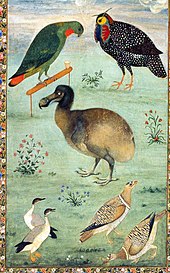
One of the most detailed descriptions is by Sir Thomas Herbert from 1634:
"First here only and in Dygarrois [now Rodrigues, likely referring to the Solitaire] is generated the Dodo, which for shape and rareness may antagonize the Phoenix of Arabia: her body is round and fat, few weigh less than fifty pound. It is reputed more for wonder than for food, greasie stomackes may seeke after them, but to the delicate they are offensive and of no nourishment. Her visage darts forth melancholy, as sensible of Nature's injurie in framing so great a body to be guided with complementall wings, so small and impotent, that they serve only to prove her bird.
The halfe of her head is naked seeming couered with a fine vaile, her bill is crooked downwards, in midst is the trill [nostril], from which part to the end tis a light green, mixed with pale yellow tincture; her eyes are small and like to Diamonds, round and rowling; her clothing downy feathers, her train three small plumes, short and inproportionable, her legs suiting her body, her pounces sharpe, her appetite strong and greedy. Stones and iron are digested, which description will better be conceived in her representation."
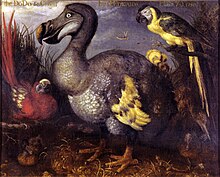
Differences in the paintings have lead authors such as Anthonie Cornelis Oudemans[21] and Masauji Hachisuka to speculate regarding sexual dimorphism, ontogenic traits, seasonal variation, and even the existence of different species, but these theories are not accepted today. Because details such as markings of the beak, the form of the tail feathers, and colouration vary from account to account, it is impossible to determine the exact morphology of these features, whether they indicate different age or sex, or if they even reflect reality. Apart from the Gelderland sketches, it is also unknown whether any of the illustrations were drawn from life or from crudely stuffed specimens, affecting their reliability. Dodo specialist Julian Hume has argued that the nostrils of the dodo would have actually been slits, as seen in the Gelderland, Saftleven, Crocker Gallery and Mansur images. According to this claim, the gaping nostrils often seen in dodo paintings were thus depicted due to drying in stuffed specimens.
The traditional image of the dodo is of a very fat and clumsy bird, but this view may be exaggerated. The general opinion of scientists today is that the old European drawings showed overfed captive specimens.[22][23] Estimations based on skeletal measurements suggest that wild Dodos might have weighed about 10.2 kilograms (22 lb).[24][25] The Dutch painter Roelant Savery was the most prolific and influential illustrator of the dodo, having made at least nine depictions. A famous painting of his from 1626 now called "Edwards' Dodo" in the British Museum has since become the standard image of a dodo. The image shows a particularly fat bird, and is the source for many other dodo illustrations.[26] A 17th century painting attributed to the Mughal artist Ustad Mansur which was rediscovered in the 1950s shows a dodo along with native Indian birds. It depicts a slimmer, brownish bird, and is regarded by professor A. Ivanov and Julian Hume as one of the most accurate depictions of a dodo.[27]
The white dodo

The supposed "Réunion Solitaire" or "White Dodo" of Réunion is now believed to have been an erroneous conjecture based on contemporary reports of the Réunion Sacred Ibis, combined with paintings by Pieter Withoos and Pieter Holsteyn from the 1600s of white dodos that surfaced in the 19th century.
Willem Ysbrandtsz. Bontekoe, who visited Reunion around 1619, mentioned that it was inhabited by "Dod-eersen", though without mentioning colouration. A white bird was first described as follows in 1625 by Mr. Tatton, the Chief Officer of Captain Castleton:
"There is store of land fowle both small and great, plenty of Doves, great Parrats, and such like; and a great fowle of the bignesse of a Turkie, very fat, and so short winged, that they cannot fly, being white, and in a manner tame: and so be all other fowles, as having not been troubled nor feared with shot. Our men did beat them down with sticks and stones. Ten men may take fowle enough to serve fortie men a day."

In 1674 these white birds were again described by Sieur D. B. Dubois:
"Solitaires. These birds are thus named because they always go alone. They are as big as a big goose and have white plumage, black at the extremity of the wings and of the tail. At the tail there are some feathers resembling those of the Ostrich. They have the neck long and the beak formed like that of the Woodcocks, but larger, and the legs and feet like those of Turkey-chicks. This bird betakes itself to running, only flying but very little. It is the best game on the Island."
19th century nauralists assumed these were descriptions of the white dodo shown in the paintings, and a new species, Didus solitarius, was erected. Walter Rothschild suggested that the reason the painted specimens had yellow wing-tips instead of black as in the old descriptions might have been albinism.[28] Others believed it was a species similar to the Rodrigues Solitaire, as it was also referred to as "solitaire", or even that there were white species of both the dodo and solitaire on the island.[29]

The Pieter Withoos painting, which was discovered first, appears to be based on an earlier painting by Pieter Holsteyn, three versions of which are known to have existed. According to Julian Hume and Anthony Cheke, it appears that all depictions of white dodos were based on a single painting or copies of it, showing a whitish specimen, made by Roelant Savery in ca. 1611 called "Landscape with Orpheus and the animals". This was apparently based on a stuffed specimen then in Prague; a walghvogel described as having a "dirty off-white colouring" was mentioned in an inventory of specimens in the Prague collection of the Holy Roman Emperor Rudolf II to whom Savery was contracted at the time (1607–1611). Savery's several later images all show grayish birds, possibly because he had by then seen another specimen.[30] It has also been suggested that the light plumage was a juvenile trait, due to bleaching of old taxidermied specimens, or simply due to artistic license.[31]
Since Reunión was not visited by Europeans until 1635, the 1611 painting could not have shown a bird from there.[32] In 1987, fossils from Réunion of a recently extinct species of ibis in the genus Threskiornis were described, and it is now believed that this bird was the source of the old sailors' descriptions, since they are white with black parts and have long, slender beaks, like woodcocks. No fossil remains of dodo-like birds have ever been found on the island.
Behaviour and ecology
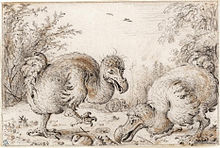
Little is known of the dodo's behaviour as most contemporary descriptions are very brief. Reports mention that the bird subsisted on fruit and nested on the ground, laying a single egg. A description by François Cauche from 1651 describes the egg and call:
"The call is like that of a gosling but they are quite unpalatable to eat... They lay one egg, which is quite as large as a penny bun, against which they lay a white stone the size of a chicken's egg. They lay their egg on a nest of grass which they collect and they place the nest in the woods. If one kills the young you find a grey stone in the gizzard. We named them the birds of Nazareth."[33]
An account of a "young ostrich" taken on board a ship in 1617 is the only other mention of a possible juvenile dodo.[34]

The preferred habitat of the dodo is unknown, but old descriptions suggest it inhabited the woods on the drier coastal areas of south and west Mauritius. Its limited distribution across the island likely contributed to its extinction.[33] A 1601 map from the journal of the ship Gelderland shows a small island off the coast of Mauritius where dodos were caught. Julian Hume believes this island was in Tamarin Bay, on the west coast of Mauritius.
Diet
A 1631 document, rediscovered in 1887 but now lost, is the only account of the dodo's diet:
"These Burgmeesters are superb and proud. They displayed themselves to us with stiff and stern faces, and wide-open mouths. Jaunty and audacious of gait, they would scarcely move a foot before us. Their war weapon was their mouth, with which they could bite fiercely; their food was fruit; they were not well feathered but abundantly covered with fat. Many of them were brought onboard to the delight of us all."[33]

As Mauritius has marked dry and wet seasons, the dodo probably fattened itself on ripe fruits at the end of the wet season to survive the dry season, when food was scarce; contemporary reports describe the bird's "greedy" appetite. Several contemporary sources state that the dodo used gizzard stones. The English historian Sir Hamon L'Estrange witnessed a live bird and described it as such:
"About 1638, as I walked London streets, I saw the picture of a strange looking fowle hung out upon a clothe and myselfe with one or two more in company went in to see it. It was kept in a chamber, and was a great fowle somewhat bigger than the largest Turkey cock, and so legged and footed, but stouter and thicker and of more erect shape, coloured before like the breast of a young cock fesan, and on the back of a dunn or dearc colour. The keeper called it a Dodo, and in the ende of a chymney in the chamber there lay a heape of large pebble stones, whereof hee gave it many in our sight, some as big as nutmegs, and the keeper told us that she eats them (conducing to digestion), and though I remember not how far the keeper was questioned therein, yet I am confident that afterwards she cast them all again."[35]

Stanley Temple hypothesised that the tambalacoque, also known as the "dodo tree", depended on the dodo for its propagation, and that its seeds would germinate only after passing through the bird's digestive tract; he claimed that the tambalacoque was now nearly extinct because of the dodo's disappearance. He force-fed seventeen tambalacoque fruits to wild turkeys and three germinated. Temple did not try to germinate any seeds from control fruits not fed to turkeys, so the significance of his findings is unclear. Temple also overlooked reports on tambalacoque seed germination by A. W. Hill in 1941 and H. C. King in 1946, who found the seeds germinated, albeit very rarely, without being abraded during digestion.[36][37][38][39]
Temple's hypothesis has been contested. Others have suggested the decline of the tree was exaggerated, or that other extinct animals may have also distributed the seeds, such as Cylindraspis tortoises, fruit bats or the Broad-billed Parrot.[40] According to Wendy Strahm and Anthony Cheke, two experts in Mascarene ecology, the tree while rare has germinated since the demise of the dodo and numbers several hundred, not 13 as claimed by Temple.[41]
Relationship with humans

Though Mauritius had previously been visited by Arab vessels and Portuguese sailors, none of them left any known records of encounters with dodos. The earliest known descriptions of the bird were made by Dutch travelers to Mauritius. Few contemporary accounts are reliable, as many seem based on earlier accounts.[42]
The first accounts appear in reports of the 1598 voyage of Admiral Jacob van Neck published in 1601, and also contain the first published illustration of the bird. According to Julian Hume, the following may be the first mention of dodos, referred to as penguins, a word not used for penguins at the time:
"We also found large birds, with wings as large as of a pigeon, so that they could not fly and were named penguins by the Portuguese. These particular birds have a stomach so large that it could provide two men with a tasty meal and was actually the most delicious part of the bird."[43]
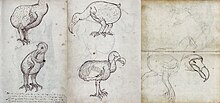
The travel journal of the Dutch East India Company ship Gelderland (1601–1603) contains the only known sketches of living or recently killed specimens on Mauritius, attributed to the professional artist Joris Joostensz Laerle, who also drew other now-extinct Mascarene birds. The travel journal was rediscovered in the 1860s.
Since the first sailors who visited Mauritius had been at sea for long, their interest in these large birds was mainly culinary. Although many later writings describe the meat as unsavory, early journals state that it was tough but good, though not as delectable as the abundantly available pigeons. Gizzard stones of the dodos were apparently used by early mariners as knife sharpeners.[44] The dodo was found interesting enough that living specimens were sent to Europe and the East. In 1626, Emmanuel Altham visited Mauritius and sent a letter to his brother in England:
"You shall receive a jar of India ginger for my sister your wife, as also some beades for my cousins your daughters, and with all a strange fowle which I had at the island of Mauritius, called by ye portingalls a Dodo, which for rareness thereof I hope will be welcome to you.
Mauritius ye 18th June 1628. Your most loving brother,
Emmanuel Altham.[45] "

It is unknown whether the dodo survived the journey, and the letter was destroyed by fire in the 19th century. At least three live birds were taken to Europe, some of which are believed to have been depicted alive and may be the source of the few non-fossil remains known today. Two live specimens were taken to India in the 1600s according to Peter Mundy, and one of them likely depicted in an Indian painting.[42] One dodo had been sent a far as Nagasaki, Japan in 1647.[46]
The journal of Willem Van West-Zanen from 1602, unpublished until 1648, describes interaction with dodos and mentions that many were hunted for food:
"They caught birds called by some Dod-aars by others Dronte. These were given the name Walghvogel during Van Neck's voyage, because even with long stewing they would hardly become tender, but stayed tough and hard with the exception of the breast and stomach which were extremely good... The sailors brought 50 birds back to the Bruin-Vis, among them 24 or 25 Dod-aarsen, so big and heavy that scarcely two were consumed at meal time, and all that were remaining were flung into salt."

An illustration made for the published version of the journal showing the killing of dodos, as well as a now locally extinct seacow, and possibly Thirioux's Grey Parrot, was captioned with the following Dutch poem, here in Errol Fuller's 2002 translation:
"For food the seamen hunt the flesh of feathered fowl,
They tap the palms, and round-rumped dodos they destroy,
The parrot's life they spare that he may peep and howl,
And thus his fellows to imprisonment decoy."
230 years before Darwin's theory of evolution, the appearance of the dodo and the Red Rail led Peter Mundy to speculate:
"Of these 2 sorts off fowl afforementionede, For oughtt wee yett know, Not any to bee Found out of this Iland, which lyeth aboutt 100 leagues From St. Lawrence. A question may bee demaunded how they should bee here and Not elcewhere, beeing soe Farer From other land and can Neither fly or swymme; whither by Mixture off kindes producing straunge and Monstrous formes, or the Nature of the Climate, ayer and earth in alltring the First shapes in long tyme, or how."[47]
Extinction

Like many animals that evolved in isolation from significant predators, the dodo was entirely fearless of humans. This fearlessness along with its inability to fly made the dodo easy prey for humans.[48] However, journals contain many reports of the bad taste and tough meat of the dodo, while praising the taste of other local species such as the Red Rail. When humans first arrived on Mauritius, they also introduced other animals, including dogs, pigs, cats, rats, and Crab-eating Macaques, which plundered the dodo nests. At the same time, humans destroyed the dodo's habitat forests;[49] the impact these introduced animals—especially the pigs and macaques—had on the dodo population is currently considered as more severe than the impact of hunting. The 2005 expedition found that animals were killed by a flash flood; such mass mortalities would have further jeopardised a species already in danger of becoming extinct.[50]
Although some scattered reports describe mass killings of dodos for ship provisions, archaeological investigations have found scant evidence of human predation. Bones of at least two dodos were found in caves at Baie du Cap, which sheltered fugitive slaves and convicts in the 17th century, and were not easily accessible to dodos due to being isolated in high, broken terrain.[51]

There is some controversy surrounding the dodo's date of extinction. The last confirmed dodo sighting on a small islet off Mauritius was reported by shipwrecked mariner Volkert Evertsz in 1662:[52]
"These animals on our coming up to them stared at us and remained quiet where they stand, not knowing whether they had wings to fly away or legs to run off, and suffering us to approach them as close as we pleased. Amongst these birds were those which in India they call Dod-aersen (being a kind of very big goose); these birds are unable to fly, and instead of wings, they merely have a few small pins, yet they can run very swiftly. We drove them together into one place in such a manner that we could catch them with our hands, and when we held one of them by its leg, and that upon this it made a great noise, the others all on a sudden came running as fast as they could to its assistance, and by which they were caught and made prisoners also."

However, many other sources suggest the more conjectural date of 1681. Roberts & Solow point out that because the sighting before 1662 was in 1638, the dodo was likely already very rare by the 1660s, and thus a disputed report from 1674 cannot be dismissed out-of-hand.[53]
Statistical analysis of the hunting records of Isaac Johannes Lamotius gives a new estimated extinction date of 1693, with a 95% confidence interval of 1688 to 1715; the last reported sighting is from these 1688 hunting records, but it has been suggested that by this time the Dutch name "dodaers" had been transferred to the likewise flightless Red Rail, now also extinct.[54] Considering more circumstantial evidence such as travelers' reports and the lack of good reports after 1689,[51] the dodo likely became extinct before 1700; the last dodo died a little more than a century after the species' discovery in 1598.[55]
Even though its rareness was reported in the 17th century, its extinction was not realised until the 19th century. This was partially because, for religious reasons, extinction was not believed to be possible until later proven by Georges Cuvier, and also because many scientists doubted the dodo had ever existed.[56] It was first used as an example of human induced extinction in Penny Magazine, 1833:
"The agency of man, in limiting the increase of the inferior animals, and in extirpating certain races, was perhaps never more strikingly exemplified than in the case of the Dodo. That a species so remarkable in its character should become extinct, within little more than two centuries, so that the fact of its existence at all has been doubted, is a circumstance which may well excite our surprise, and lead us to a consideration of similar changes which are still going on from the same cause."[57]
Surviving remains
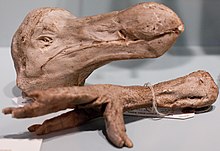
The only existing remains of the dodos that were taken to Europe in the 17th century are a dried head and some foot bones in Oxford University Museum of Natural History, an upper jaw (specimen NMP P6V-004389) and leg-bones in the National Museum (Prague),[58] a skull in the University of Copenhagen Zoological Museum, and a dried foot once housed in the British Museum, which is now lost. Several other stuffed dodos were mentioned in old museum inventories, but none of these are known to have survived.[59]
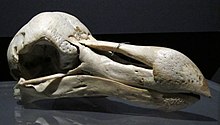
The only known soft tissue remains, the head and foot, belonged to the last known stuffed dodo, which had first been kept in the Tradescant collection, and later Oxford's Ashmolean Museum. Around 1755, however, the museum's curator or director ordered the remaining pieces discarded because of severe decay. Status eight of the museum states:
"That as any particular grows old and perishing the keeper may remove it into one of the closets or other repository; and some other to be substituted."[60]
Unfortunately no substitute existed, and most of the specimen was burned, but the head and right foot were cut off and saved for posterity. This remaining soft tissue has since degraded further, as the head was dissected in the late 19th century, separating the skin from the skull, and the foot is in a skeletal state.[61]
Few took notice of the bird immediately after its extinction. By the early 19th century it seemed altogether too strange a creature, and many believed it a myth. In 1848, H. E. Strickland and A. G. Melville published a book titled The Dodo and Its Kindred; or the History, Affinities, and Osteology of the Dodo, Solitaire, and Other Extinct Birds of the Islands Mauritius, Rodriguez, and Bourbon in which they attempted to separate Dodo myth from reality.

With the discovery of the first batch of sub-fossil dodo bones in the Mauritian swamp, the Mare aux Songes, and the reports written about them by George Clark, government schoolmaster at Mahébourg, from 1865 on, interest in the bird was rekindled. Clark, who had finally found dodo remains after searching for thirty years, explained his procedure to The Ibis:
"After many fruitless visits to the spot... I resolved by sending some men into the centre of the marsh, where the water was about three feet deep and there, by feeling in the mud with their naked feet, they met with one entire tibia, a portion of another, and a tarso-metatarsus. The dodo bones were imbedded only in the mud at the bottom of the water in the deepest part of the marsh... Encouraged by success, I employed several hands to search in the manner described, but I met with but few specimens of dodo bones till I thought of cutting away a mass of floating herbage nearly two feet in thickness, which covered the deepest part of the marsh. In the mud under this, I was rewarded by finding bones of many dodos."[62]
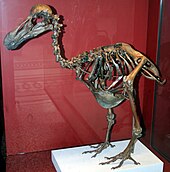
Sir Richard Owen and Alfred Newton both wanted to be the first to describe the post-cranial anatomy of the dodo, and Owen ended up buying a shipment of dodo bones originally meant for Newton. Owen described the dodo bones in Memoir on the Dodo in October 1866, whereas Newton moved his focus to the Reunion solitaire instead. However, Owen had erroneously based his dodo reconstruction on the "Edwards' Dodo" painting by Savery, which made it too squat and obese.[63]
The Natural History Museum, American Museum of Natural History, Cambridge University Museum of Zoology[64], and the Senckenberg Museum, among others, have almost complete specimens assembled from the dissociated remains found in the swamp. 26 museums around the world have significant holdings of dodo material. An alleged dodo egg is on display at the East London museum in South Africa, but genetic studies are underway to determine its authencity.[65]
In October 2005, part of the Mare aux Songes, the most important site of dodo remains, was excavated by an international team of researchers. Many remains were found, including bones from birds of various stages of maturity,[66] and several bones obviously belonging to the skeleton of one individual bird and preserved in natural position.[12] These findings were made public in December 2005 in the Naturalis museum in Leiden. The finds showed that 7.1% of the fossil remains found in the swamp belonged to dodos, and that they had accumulated over several centuries.[67] Subsequent excavations suggested that dodos, along with other animals, became mired in Mare aux Songes trying to reach available water during a long period of severe drought about 4,200 years ago.[68][69]
In June 2007, adventurers exploring a cave in Mauritius discovered the most complete and best-preserved dodo skeleton ever.[70]
A wooden box full of dodo bones from the Edwardian era was rediscovered at the Grant Museum in 2011, during preparation for the museum to move into a new building.[71]
Cultural significance

In the same year in which George Clarke started to publish his reports about excavated dodo fossils, the newly vindicated bird was featured as a character in Lewis Carroll's Alice's Adventures in Wonderland. With the popularity of the book, the dodo became a well-known and easily recognizable icon of extinction.[72]
Today it regularly appears in works of popular fiction, and is used as mascot for many kinds of products, especially on Mauritius. The dodo rampant appears on the coat of arms of Mauritius.[49] A smiling dodo is the symbol of the Brasseries de Bourbon, a popular brewer on Reunion Island, a reference to the white species which was once thought to live there.
The dodo's significance as one of the best-known extinct animals and its singular appearance has led to its use in literature and popular culture to symbolise a concept or object that will or has become out of date, as in the expression "dead as a dodo" which has come to mean undoubtedly and unquestionably dead, while the phrase "to go the way of the dodo" means to become extinct or obsolete, to fall out of common usage or practice, or to become a thing of the past, both in reference to the untimely extinction of the bird.[73][74] Coincidentally, the word dodo is an anagram for the Dutch word for dead, "dood".
The dodo is used by many environmental organizations that promote the protection of endangered species, such as the Durrell Wildlife Conservation Trust and the Durrell Wildlife Park, founded by Gerald Durrell.[75] In 2011, the nephilid spider Nephilengys dodo, which inhabits the forests where the dodo once lived, was named after the bird to raise awareness of the urgent need of the Mauritius biota.
In 2009 a previously unpublished 17th century Dutch illustration of a dodo went for sale at Christie's, and was expected to sell for £6,000.[76] It is unknown whether it was drawn after a live or stuffed specimen, or simply a copy of another image. It was sold for £44,450.[77]
See also
References
- ^ "The Oxford Dodo" (PDF). Learning More. The Oxford University Museum of Natural History. Retrieved 13 September 2011.
- ^ Template:IUCN2011.1
- ^ "The Dodo – Raphus Cuccullatus". Retrieved 2011-11-17.
- ^ Reinhardt, J. T. Nøjere oplysning om det i Kjøbenhavn fundne Drontehoved. Krøyer, Nat. Tidssk. IV., 1842–43, pp. 71–72. 2.
- ^ Strickland, H.E. (1848) The Dodo and its Kindred London: Reeve, Benham and Reeve. p.128
- ^ Shapiro, Beth; Sibthorpe, Dean; Rambaut, Andrew; Austin, Jeremy; Wragg, Graham M.; Bininda-Emonds, Olaf R. P.; Lee, Patricia L. M. & Cooper, Alan (2002): Flight of the Dodo. Science 295: 1683. doi:10.1126/science.295.5560.1683 (HTML abstract) Free PDF Supplementary information
- ^ "DNA yields dodo family secrets". BBC News. London. 2002-02-28. Retrieved 2006-09-07.
- ^ http://www.marineornithology.org/PDF/35_2/35_2_97-107.pdf
- ^ Johnson, Kevin P. and Dale H. Clayton (2000): Nuclear and Mitochondrial Genes Contain Similar Phylogenetic. Signal for Pigeons and Doves (Aves: Columbiformes). Molecular Phylogenetics and Evolution 14(1): 141–151. PDF fulltext
- ^ Janoo 2005
- ^ Staub, France (1996): Dodo and solitaires, myths and reality. Proceedings of the Royal Society of Arts & Sciences of Mauritius 6: 89–122 HTML fulltext
- ^ a b "Dodo skeleton find in Mauritius". BBC News. London. 2006-06-24. Retrieved 2006-08-28.
- ^ The Portuguese word doudo or doido may itself be a loanword from Old English (cf. English "dolt").
- ^ Quammen, David (1996): The Song of the Dodo: Island Biogeography in an Age of Extinction. Touchstone, New York. ISBN 0-684-82712-3
- ^ Kitchener A.C., "Justice at last for the dodo", New Scientist p.24, 28 August 1993.[1]
- ^ LOST LAND OF THE DODO: An Ecological History of Mauritius, Réunion, and Rodrigues. Anthony Cheke and Julian Hume. 464 pp. Yale University Press, 2008
- ^ Attention: This template ({{cite doi}}) is deprecated. To cite the publication identified by doi:10.1111/j.1469-7998.1989.tb02535.x, please use {{cite journal}} (if it was published in a bona fide academic journal, otherwise {{cite report}} with
|doi=10.1111/j.1469-7998.1989.tb02535.xinstead. - ^ Attention: This template ({{cite doi}}) is deprecated. To cite the publication identified by doi:10.1111/j.1469-7998.1993.tb02686.x, please use {{cite journal}} (if it was published in a bona fide academic journal, otherwise {{cite report}} with
|doi=10.1111/j.1469-7998.1993.tb02686.xinstead. - ^ Fuller, Errol: The Dodo – Extinction In Paradise, 2003
- ^ Rothschild, Walter (1907). Extinct Birds (PDF). London: Hutchinson & Co. p. 172.
- ^ Oudemans, 1917
- ^ Kitchener, A. On the external appearance of the dodo, Raphus cucullatus. Archives of natural History, 20, 1993.[2]
- ^ "p221-229.vp" (PDF). Retrieved 2012-05-12.
- ^ Angst, Delphine; Buffetaut, Eric; Abourachid, Anick (2011). "The end of the fat dodo? A new mass estimate for Raphus cucullatus". Naturwissenschaften. 98: 233–236. doi:10.1007/s00114-010-0759-7.
- ^ Angst, Delphine; Buffetaut, Eric; Abourachid, Anick (2011). "In defence of the slim dodo: a reply to Louchart and Mourer-Chauviré". Naturwissenschaften. 98: 359–360. doi:10.1007/s00114-011-0772-5.
- ^ "George Edwards: The Bedell and His Birds - Adair Stuart Mason - Google Books". Books.google.com. Retrieved 2012-05-12.
- ^ Dissanayake, Rajith (2004). "What did the dodo look like?" (PDF). The Biologist. 51 (3). Society of Biology: 165–168. Retrieved 14 September 2011.
- ^ Rothschild, Walter (1907). Extinct Birds (PDF). London: Hutchinson & Co. pp. 176, Plate 25.
- ^ M. Hachisuka (1953). The Dodo and Kindred Birds. London: Witherby.
- ^ Cheke, Anthony S. and Julian Pender Hume. "The white dodo of Réunion Island" (PDF). Retrieved 2009-01-18.
- ^ Attention: This template ({{cite doi}}) is deprecated. To cite the publication identified by doi:10.1093/jhc/15.2.201, please use {{cite journal}} (if it was published in a bona fide academic journal, otherwise {{cite report}} with
|doi=10.1093/jhc/15.2.201instead. - ^ "Zoologische Mededelingen 79-03" (PDF). Retrieved 2012-05-12.
- ^ a b c Fuller, Errol: Dodo – From Extinction To Icon, 2002
- ^ Cheke, Hume: Lost Land of the Dodo, 2008
- ^ Fuller, Errol (2001). Extinct Birds (revised ed.). Comstock. ISBN 0-8014-3954-X., pp. 96–97
- ^ Temple, Stanley A. (1977): Plant-animal mutualism: coevolution with Dodo leads to near extinction of plant. Science 197(4306): 885–886. HTML abstract
- ^ Hill, A. W. (1941): The genus Calvaria, with an account of the stony endocarp and germination of the seed, and description of the new species. Annals of Botany 5(4): 587–606. PDF fulltext (requires user account)
- ^ King, H. C. (1946). Interim Report on Indigenous Species in Mauritius. Government Printer, Port Louis, Mauritius.
- ^ Witmer, M. C. & Cheke, A. S. (1991): The dodo and the tambalacoque tree: an obligate mutualism reconsidered. Oikos 61(1): 133–137. HTML abstract
- ^ "Plant Science Bulletin, 2004, Volume 50, Issue 4". Botany.org. Retrieved 2012-05-12.
- ^ Attention: This template ({{cite jstor}}) is deprecated. To cite the publication identified by jstor:3545415, please use {{cite journal}} with
|jstor=3545415instead. - ^ a b Hume, Julian P. (2006). "The history of the Dodo Raphus cucullatus and the penguin of Mauritius" (PDF). Historical Biology. 18 (2): 65–89. doi:10.1080/08912960600639400. ISSN 0891-2963. Retrieved 14 September 2011.
- ^ Moree 1998, p. 12
- ^ Strickland, Hugh E. (1848). The Dodo and its Kindred; or the history, affinities, and osteology of the Dodo, Solitaire, and other extinct birds of the Islands Mauritius, Rodriguez, and Bourbon. London, UK: Reeve, Benham and Reeve. p. 43.
- ^ "Mauritius Illustrated: Historical and Descriptive, Commercial and Industrial ... - Allister Macmillan - Google Břger". Books.google.dk. Retrieved 2012-05-12.
- ^ Millies (1868), Newton (1868)
- ^ Mundy (1628–1634) 1914, p. 353
- ^ "Scientists pinpoint dodo's demise". BBC News. London. 2003-11-20. Retrieved 2006-09-07.
- ^ a b Jonathan Fryer (2002-09-14). "Bringing the dodo back to life". BBC News. London. Retrieved 2006-09-07.
- ^ Tim Cocks (2006-06-04). "Natural disaster may have killed dodos". Reuters. Retrieved 2006-08-30.
- ^ a b Janoo, Anwar (2005): Discovery of isolated dodo bones [Raphus cucullatus (L.), Aves, Columbiformes] from Mauritius cave shelters highlights human predation, with a comment on the status of the family Raphidae Wetmore, 1930. Annales de Paléontologie 91: 167–180. [English with French abstract] doi:10.1016/j.annpal.2004.12.002 (HTML abstract) Hume et al. ref probably too.
- ^ ""The Dodo's last island", Royal Society of Arts and Sciences of Mauritius" (PDF). Dodobooks.com. Retrieved 2012-05-12.
- ^ Roberts, David L. & Solow, Andrew R. (2003): Flightless birds: When did the dodo become extinct? Nature 425(6964): 245. doi:10.1038/426245a (HTML abstract)
- ^ Attention: This template ({{cite doi}}) is deprecated. To cite the publication identified by doi:10.1038/nature02688, please use {{cite journal}} (if it was published in a bona fide academic journal, otherwise {{cite report}} with
|doi=10.1038/nature02688instead. - ^ "Dodo Bird FAQs". Wikifaq.com. Retrieved 2012-05-12.
- ^ Attention: This template ({{cite doi}}) is deprecated. To cite the publication identified by doi:10.1080/08912960802376199, please use {{cite journal}} (if it was published in a bona fide academic journal, otherwise {{cite report}} with
|doi=10.1080/08912960802376199instead. - ^ Broderip 1833; reprinted in the Penny Cyclopaedia
- ^ Type specimens of recent vertebrates in the collections of the National Museum, Prague, Czech Republic Jiří Mlíkovský, Petr Benda, Jiří Moravec & Radek Šanda
- ^ Attention: This template ({{cite doi}}) is deprecated. To cite the publication identified by doi:10.3366/anh.1992.19.2.145, please use {{cite journal}} (if it was published in a bona fide academic journal, otherwise {{cite report}} with
|doi=10.3366/anh.1992.19.2.145instead. - ^ "The Ashmolean as a museum of natural history, 1683-1860" (PDF). Retrieved 2012-05-12.
- ^ "Unpublished drawings of the Dodo Raphus cucullatus and notes on Dodo skin relics" (PDF). Bull. B. O. C. 126A: 49–54. 2006. ISSN 0007-1595. Retrieved 14 September 2011.
{{cite journal}}:|first=missing|last=(help) - ^ http://extinct-website.com/pdf/ibis02brit1.pdf
- ^ Attention: This template ({{cite doi}}) is deprecated. To cite the publication identified by doi:10.1080/08912960903101868, please use {{cite journal}} (if it was published in a bona fide academic journal, otherwise {{cite report}} with
|doi=10.1080/08912960903101868instead. - ^ "University Museum of Zoology, Cambridge | Birds". Museum.zoo.cam.ac.uk. 2010-01-13. Retrieved 2012-05-12.
- ^ Laing, Aislinn (2010-08-27). "Last surviving Dodo egg could be tested for authenticity". The Daily Telegraph. London.
- ^ "Scientists find 'mass dodo grave'". BBC News. London. 2005-12-24. Retrieved 2006-09-07.
- ^ Attention: This template ({{cite doi}}) is deprecated. To cite the publication identified by doi:10.1016/j.quascirev.2008.09.018, please use {{cite journal}} (if it was published in a bona fide academic journal, otherwise {{cite report}} with
|doi=10.1016/j.quascirev.2008.09.018instead. - ^ "Meijer, Hanneke J. M., Arike Gill, Perry G. B. de Louw, Lars W. Van Den Hoek Ostende, Julian P. Hume, and Kenneth F. Rijsdijk. 2012. Dodo remains from an in situ context from Mare aux Songes, Mauritius. Naturwissenschaften 99 (3): 177-184". Rd.springer.com. 2012-03-01. Retrieved 2012-05-12.
- ^ "Perkins, Sid. Death by dry spell. ScienceNOW. (Posted: 30 March 2012)". Rd.springer.com. 2012-03-01. Retrieved 2012-05-12.
- ^ "Dodo Skeleton Found on Island, May Yield Extinct Bird's DNA". National Geographic. 2007-07-03. Retrieved 2007-07-09.
- ^ Maev Kennedy. "Half a dodo found in museum drawer | Science". The Guardian. Retrieved 2012-05-12.
- ^ Mayell, Hillary (2002-02-28). "Extinct Dodo Related to Pigeons, DNA Shows". National Geographic News. Retrieved 2009-01-19.
- ^ Steve Miller (2006-09-25). "First The Dodo, Now Full-Size SUV". Brand Week. Archived from the original on September 27, 2007. Retrieved 2006-09-26.
{{cite web}}: Unknown parameter|deadurl=ignored (|url-status=suggested) (help) - ^ "Water ford Wildlife". Water ford Today. 2006-01-01. Retrieved 2006-09-26.
- ^ Dee pa Unhook (2006-09-26). "Mauritius: Footprints From the Past". expresser's. Retrieved 2006-09-26. (requires subscription)
- ^ Jamieson, Alastair (2009-06-22). "Uncovered: 350-year-old picture of dodo before it was extinct". The Daily Telegraph. London.
- ^ "Dutch School, 17th Century | A dodo | Old Master Drawings Auction | Drawings & Watercolors, watercolor | Christie's". Christies.com. Retrieved 2012-05-12.
External links
- The Dodo – The merging of myth and reality: Half hour video interview with dodo expert Julian Hume
Template:Link FA Template:Link FA Template:Link FA Template:Link GA

